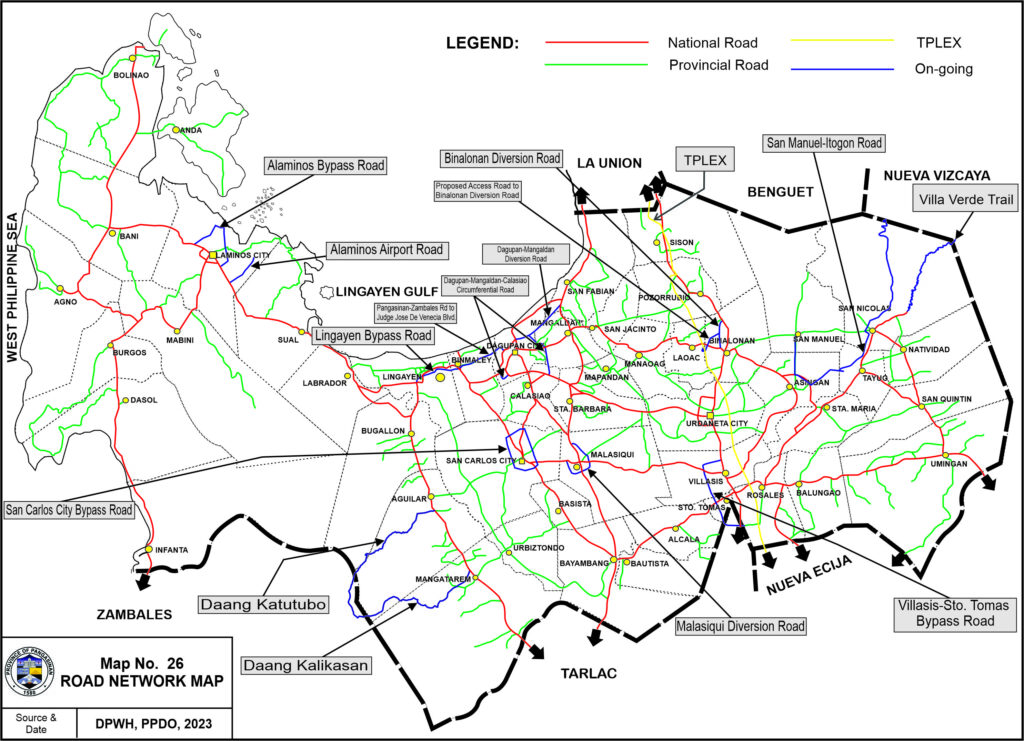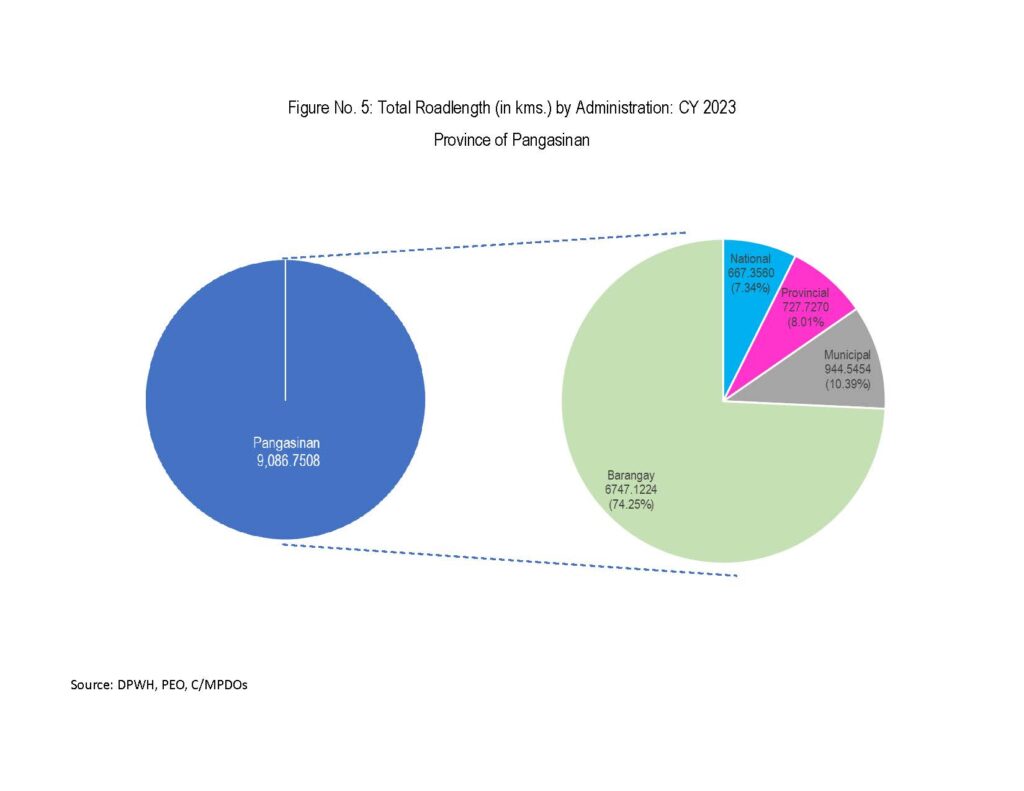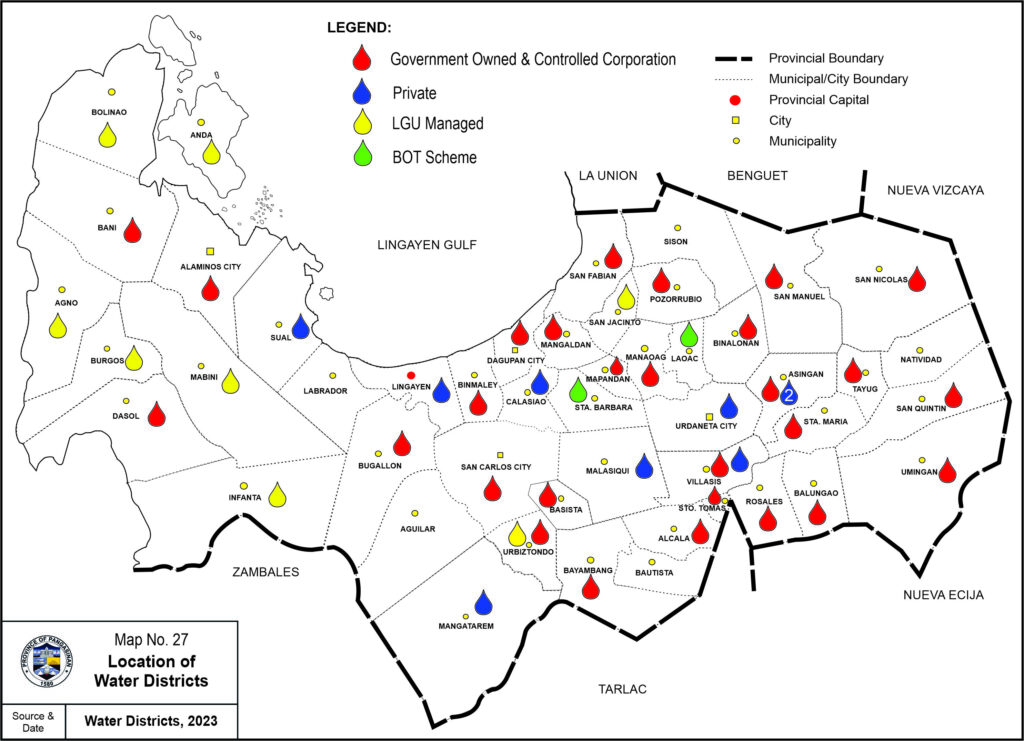A nation’s economic growth and development depends mostly on its great investments in infrastructure projects and a breakthrough on communication systems. Infrastructure not only provides better connectivity, but also enhances production and efficiency. However, proper planning, to include accuracy and reliability of data gathered, must be ensured to really spur development and economic growth.
Information on the land transportation, communications, electrification, water supply, and other data on major utilities and facilities in the province are provided to planners, researchers, students and every individual for their evaluation, recommendation, study, formulation and usage of well oriented policies. These data are also useful indicators in planning in all sectors of development.
Roads
A gateway to the North, Pangasinan is accessible through the following major thoroughfare:
- Manila North Road; a north to south backbone that extends from Carmen, Rosales up to the Municipality of Sison;
- Romulo Highway via Tarlac (Pangasinan-Tarlac Road);
- Pangasinan-Zambales Road (Olongapo-Alaminos-Bugallon road) connecting the province of Zambales in Region III;
- Pangasinan-Nueva Ecija Road which links Pangasinan to Nueva Ecija;
- Pangasinan-Nueva Vizcaya Road (links the province to Region II via Villa Verde Trail going to Sta. Fe Nueva Vizcaya);
- Pangasinan-La Union Road, linking Pangasinan to province of La Union;
- Tarlac-Pangasinan-La Union Expressway (TPLEx);
- San Nicolas-Natividad-San Quintin-Umingan-Guimba Road;
- San Nicolas-Natividad-San Quintin-Umingan-Guimba Road 2 linking the province to Nueva Ecija in Region III; and
- Camiling-Wawa Bayambang-Malasiqui, Sta. Barbara Road also linking Pangasinan to Tarlac.
The total road length of the province for the year 2023 is 9,086.7508 kms. National Road recorded 667.356 kilometers representing 7.34% of the total road length of Pangasinan, Provincial Road with 727.7270 kilometers or 8.01%, Municipal Road with 944.5454 kilometers or 10.39%, and Barangay Roads which has the longest with 6,747.1224 kilometers or 74.25% share of the total provincial road length.
District I had the longest road length of 2388.0877 kilometers sharing about 26.28% of the province’s total road network, while District IV had the least with 759.5506 kilometers or about 8.36%.
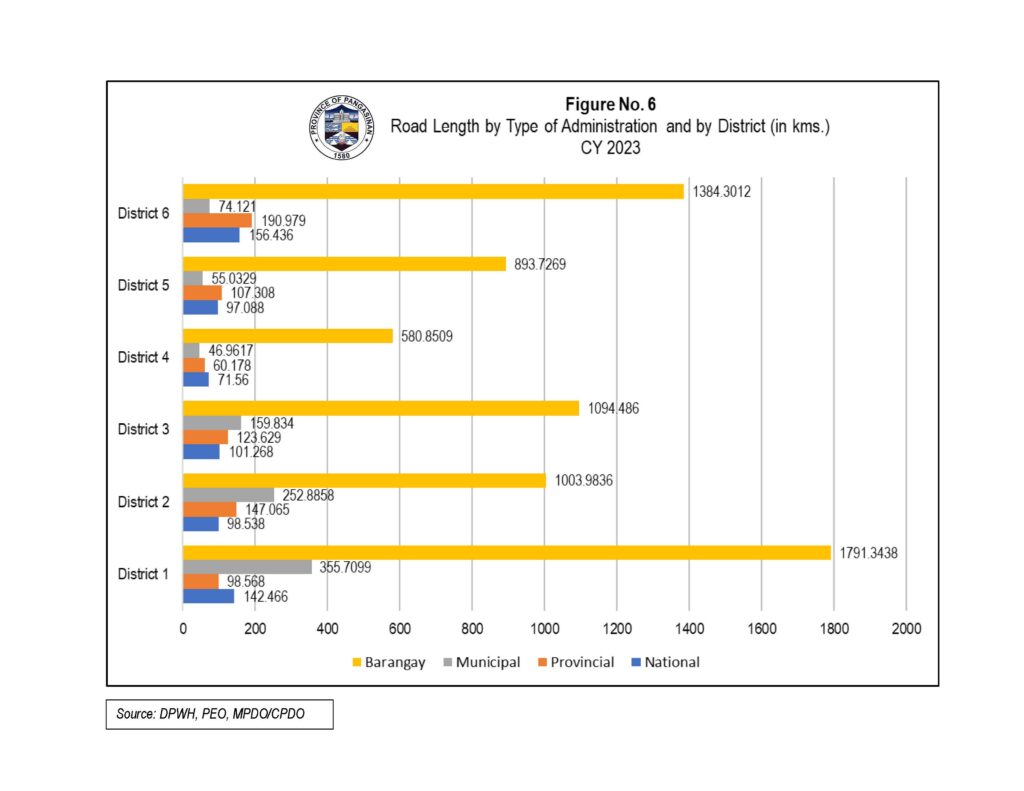 Of the total road network, 6,201.1775 kilometers or 68.24% are paved, while 2,885.5733 kilometers or about 31.76% still remains unpaved.
Of the total road network, 6,201.1775 kilometers or 68.24% are paved, while 2,885.5733 kilometers or about 31.76% still remains unpaved.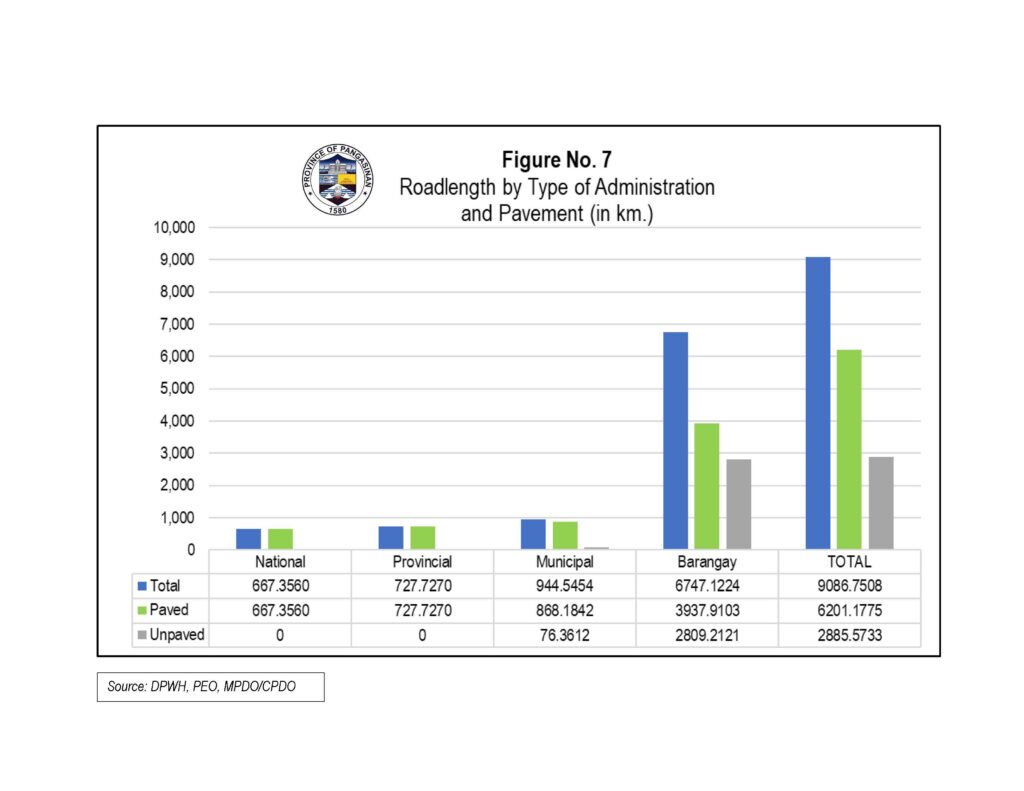 In terms of road density, Pangasinan has a road density of 1.67 km/sq.km of its total land area and 2.77 km/1,000 population (2023 projected), which is still adequate compared to the standards of 1.0 km/sq. km. and 1km/1,000 population.
In terms of road density, Pangasinan has a road density of 1.67 km/sq.km of its total land area and 2.77 km/1,000 population (2023 projected), which is still adequate compared to the standards of 1.0 km/sq. km. and 1km/1,000 population.
Bridges
The province’s total length of bridges is 39,828.82 linear meters. National Bridges recorded the longest (by Administration) with a total of 14,583.96 linear meters, which is about 36.62% of the total province’s bridge length. Followed by Barangay Bridges with 13,923.85 linear meters or about 34.96%, Provincial Bridges with 5,916.13 linear meters or 14.85%, and Municipal Bridges with 5,404.88 linear meters or 13.57%. District VI has the longest bridge length with 10,012.73 linear meters or 25% of the total province’s bridge length, while District III has the least with 4,202.05 linear meters or about 11%.
District VI has the longest bridge length with 10,012.73 linear meters or 25% of the total province’s bridge length, while District III has the least with 4,202.05 linear meters or about 11%.
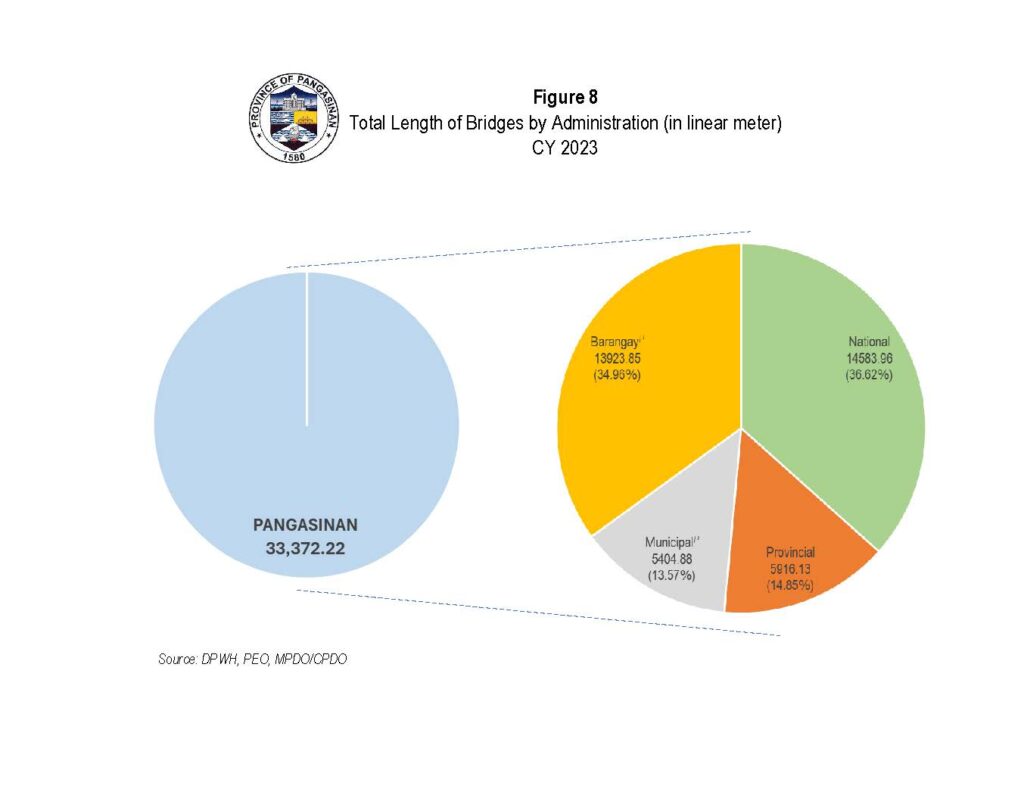 All national and provincial bridges are already made of permanent structures. Municipal and Barangay Bridges with permanent structures are recorded at 15,673.07 linear meters or about 81% of the total Municipal and Barangay bridge length, while the remaining 3,655.68 linear meters or 19% are still made up of temporary structures.
All national and provincial bridges are already made of permanent structures. Municipal and Barangay Bridges with permanent structures are recorded at 15,673.07 linear meters or about 81% of the total Municipal and Barangay bridge length, while the remaining 3,655.68 linear meters or 19% are still made up of temporary structures.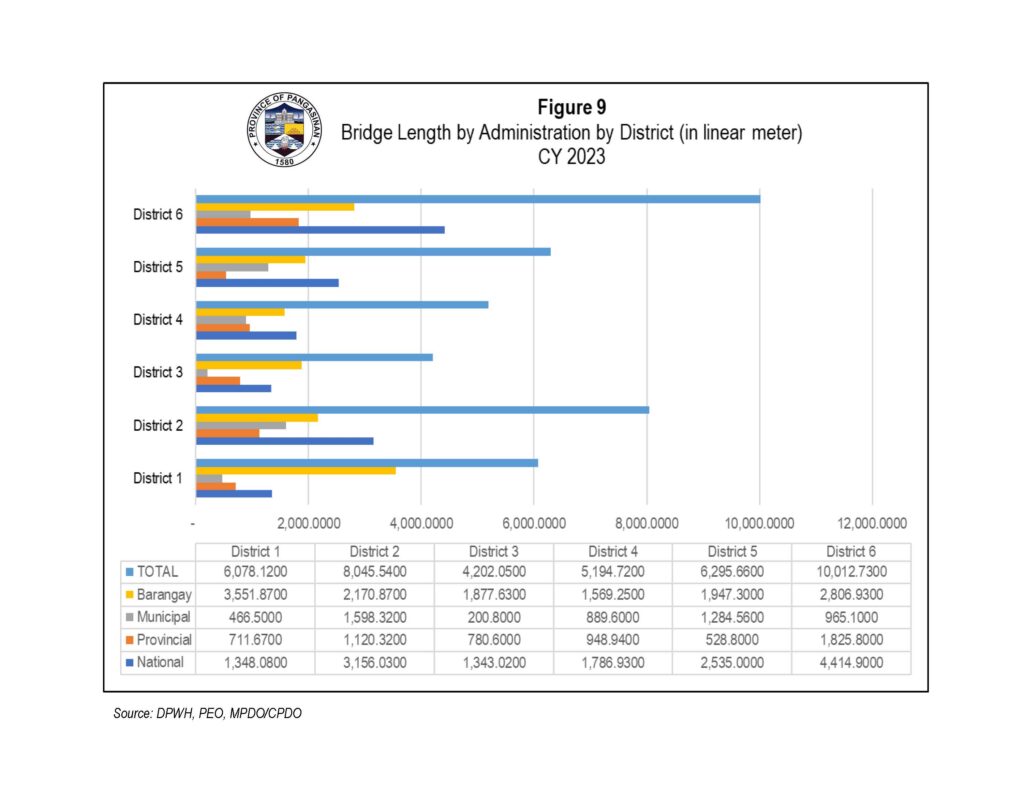 Irrigation System
Irrigation System
For the year 2023, the irrigation coverage of the province was placed at 61% representing 113,338 hectares irrigated from the potential irrigable area of 185,058 hectares.
Domestic Water Supply
Potable water supply is being served by the 47 water districts/waterworks associations and privately-owned water associations located in different parts of the province categorized into residential, commercial and industrial. Residential had the highest connections with 272,802 an increase of 5.62% or 14,513 connections over the previous year’s figure of 258,289. Meanwhile, commercial and industrial/government had 15,557 and 2,516 connections, respectively.
Among the water service providers, Dagupan City Water District exhibited the highest number of residential connections with 27,713 consumers. This was followed by Alaminos City with 18,782 connections and Mangaldan with 15,051. However, in terms of water consumption for all type of clients, Alaminos City Water District registered the highest figure with a total of 4,906,958 cubic meters, followed by Dagupan City Water District with 4,807,388 cubic meters and Bayambang Water District with 3,761,912 cubic meters.
Of the forty-eight (48) cities/municipalities in the province, five (5) municipalities (Aguilar, Labrador, Sison, Natividad, and Bautista) do not have an existing water district or waterworks system within their municipality. However, some LGUs sourced out their water supply from their neighboring municipality.
Electric Power Supply
One hundred percent (100%) of the barangays in Pangasinan have been energized. A total of 764,706 households were energized by the different electric cooperatives in the province. There were 17 cities/municipalities catered by Panelco III, 14 by Cenpelco, 9 by Panelco I, and 7 by Decorp.
As to consumption, household connections posted the highest consumption at 695,486,572 kwh, with an average consumption of 1,052 kwh per household. On the other hand, Street Light end users have the least number of connections registering a total consumption of 7,071,719 kwh.
There are five (5) electric cooperatives providing electrical services in the province, namely: Pangasinan Electric Coops I and III (PANELCO I & III), Central Pangasinan Electric Coop (CENPELCO), Dagupan Electric Corporation (DECorp), and the La Union Electric Coop (LUELCO). The latter provides electrical services to some barangays in the municipality of Sison. The cost per kilowatt hour of the different Electric Cooperatives varies by type of consumers. For residential, excluding LUELCO, PANELCO III has the highest rate/kwh with P13.1293 followed by PANELCO I with Php 12.3651. On the other hand, DECORP has the lowest cost with 10.6927.
The province has 2 power generation plants, the Sual Coal-Fired Power Plant and the San Roque Hydro Power Plant located in the municipalities of Sual and San Manuel, respectively. These power plants have a combined generating capacity of 1,545 MW and have several transmission lines carrying high voltage of 69 KV, 230 KV and 500 KV.
Transport Facilities
A total of 344,043 motor vehicles were registered in CY 2023, which had increased by 7.21% or 23,141 vehicles compared to last year’s figure of 320,902 registered motor vehicles. By vehicle classification, private vehicles recorded the highest number of registration with 303,406 vehicles or about 88.18% of the total registered vehicles, followed by vehicles “for hire” with 38,743 vehicles or 11.26%, and government vehicles with only 1,880 vehicles or 0.55%.
For the various types of motor vehicles, motorcycle/tricycle always posted the highest number of registration, with this year’s 227,851 or 66.2% of the total number vehicles registered. This is followed by the utility vehicles with 55,908 or 16.25%, cars with 30,413 or 8.83%, sports utility vehicles with 20,328 or 5.91%, trucks with 8,734 or 2.54%, and trailers with 667 or 0.19%. Posted with the least registration are buses with only 142 or 0.04% of the total registered vehicles.
Out of the total registered motor vehicles, 273,047 or 79.36% are using gasoline, while 70,306 or 20.43% use diesel. Compared to last year’s data of 320,906, about 215,766 used gasoline and 65,370 vehicles used diesel.
Communication Facilities
In 2022, the postal services are being provided by 50 post offices giving more than 100% coverage for the province. For the year under review, one (1) post office served 64,766 individuals. For the same period, there are 102 letter carriers in the province, serving 31,748 persons per letter carrier. The ratios of both the post office and the letter carrier to population are above the standard ratio of 1:6000 and 1:5000.
Print media and local news are mediums of information in the province. There are 14 print local publications being circulated. Also, there are 19 existing cable stations and 20 broadcast/radio stations that are currently in operation.
The province is fully served with telephone services provided by PLDT making it at 100% coverage. A total of 198,414 equipped telephone lines have been installed province wide, making a telephone density of 6.6 for every 100 persons for the year under review.
In terms of electronic services, the province had fifteen (15) Internet Service Provider (ISP) facilities mostly located in the cities of Dagupan and San Carlos. In addition, numerous Internet Cafés installed provincewide are likewise providing internet services to the public.
Solid Waste Disposal
In disposing of solid wastes, there were seven (7) LGUs using open dumpsite and ten (10) use Sanitary Landfill Facility, namely: Agno, Alaminos City, Bolinao, Burgos, Infanta, Malasiqui, San Carlos City, Manaoag, Urdaneta City, and Sta. Maria.
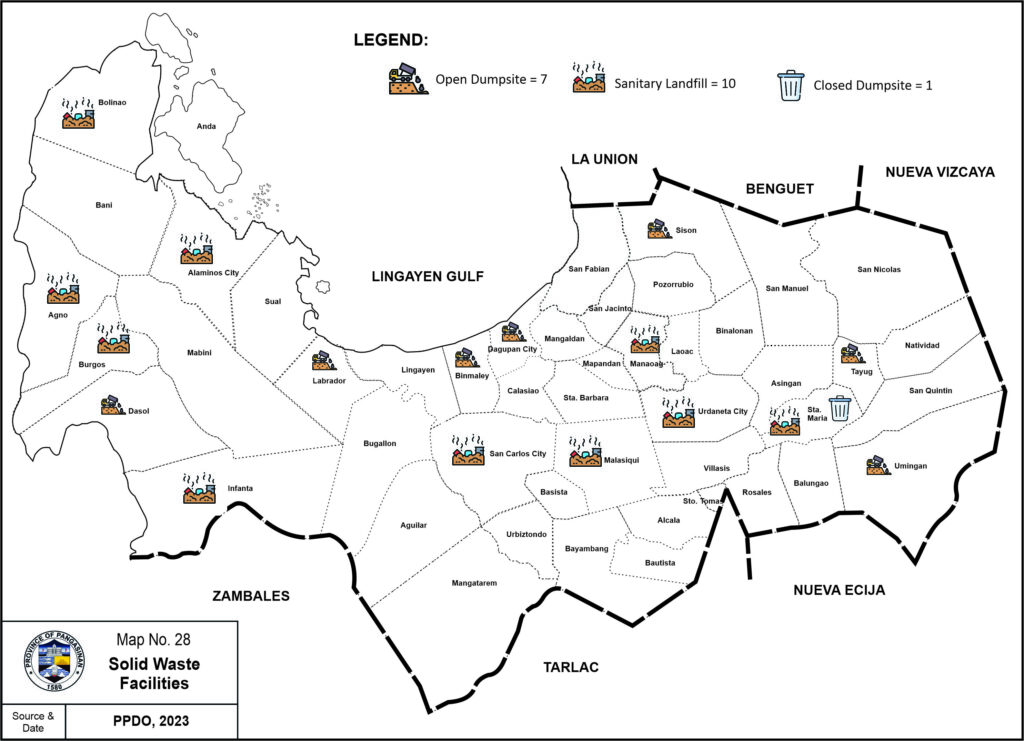 From the total number of barangays in the province (1,364), there are 1,110 or 81.38% have Material Recovery Facilities (MRF), which is getting closer the standard of 1 MRF for every barangay. In addition, thirty-seven (37) Central MRF are established in some local government units in the province, which are funded by the National Solid Waste Management Commission (NSWMC), while 12 are LGU-initiated. On the other hand, there are 32 LGUs who have 100% compliance in the establishment of MRF in every barangay.
From the total number of barangays in the province (1,364), there are 1,110 or 81.38% have Material Recovery Facilities (MRF), which is getting closer the standard of 1 MRF for every barangay. In addition, thirty-seven (37) Central MRF are established in some local government units in the province, which are funded by the National Solid Waste Management Commission (NSWMC), while 12 are LGU-initiated. On the other hand, there are 32 LGUs who have 100% compliance in the establishment of MRF in every barangay.
Slaughterhouse
Among the forty-eight (48) cities/municipalities of the province, forty-one (41) have existing slaughterhouse, which shows that seven (7) or 15% of the total number of local government units have no slaughterhouse.
Public Market
All the municipalities and cities of Pangasinan have their own public markets.
In addition, there are three (3) livestock markets that are located in Alaminos City, Urdaneta City and Calasiao and three (3) carabao/cattle markets in San Carlos City, Urdaneta City and San Jacinto.
Ports
Based from the Philippine Ports Authority (PPA) 2022 data, the province has six (6) registered ports, of which, five (5) are temporary/non-commercial ports, which handle their own cargoes/products, and the Sual Government Port that handles commercial cargoes, but can only accommodate small vessels at present.
Shipcalls is the number of vessels which call or arrive at a particular port at any given time. In the province, there were 350 domestic and foreign ship calls that were recorded at the various ports and anchorages. More than half of which, or 136 vessels were reported to have called/arrived at the Team Sual Corporation, 39 at Pryce Gas Inc. and 126 at the Sual Government Port.
The total volume of cargo discharged and loaded is 3,173,857 metric tons in 2022. Bulk of which is from Team Sual Corporation with 2,157,969 metric tons, while the remaining are from the Pryce Gases, Inc., Macroserve Mining, Inc., and Sual Government Port.

